- The Cloud Kitchen Market: Where it Stands Today
- Everything About Kitopi Kitchen
- Steps to Build a Cloud Kitchen Platform like Kitopi
- Choose the Right Business Model
- Design a Scalable and Robust Platform Architecture
- Build a Seamless Order Management System (OMS)
- Implement an Effective Kitchen Display System (KDS)
- Design a User-Friendly Interface for Customers and Admins
- Restaurant Onboarding and Partner Management
- Ensure Security and Data Privacy
- Conduct Thorough Testing and Quality Assurance
- Launch, Monitor, and Iterate
- Must-Have Features of a Kitchen Platform like Kitopi
- How to Set Up a Cloud Kitchen Anywhere in the World
- Choosing the Best Cloud Kitchen Model
- Operational Considerations of Cloud Kitchen
- Technical Requirements Of Cloud Kitchen
- How Much Do Cloud Kitchens Cost?
- How to Monetize a Cloud Kitchen Platform
- Subscription Plans for Restaurants
- Renting Kitchen Space (Cloud Kitchen as a Service)
- Commission-Based Earnings
- Delivery & Logistics Fees
- Sponsored Listings & Brand Collaborations
- Virtual Brand Franchising
- Data & Analytics Subscription
- Launch Your Digital-First Cloud Kitchen with Appinventiv
- FAQs
- Q. How does cloud kitchen work?
- Q. Are there any challenges in setting up ghost kitchens?
- Q. How to build a cloud kitchen platform?
- Q. What are some of the popular cloud kitchen business models?
- Q. How to invest in cloud kitchens?
What’s the future of dining?
It might just be the cloud kitchen.
A model that has rapidly gained momentum, ghost kitchens are projected to account for over 50% of all food delivery orders by 2025. (Source: Statista)
Brands like McDonald’s and KFC are already tapping into this model, sharing kitchen spaces with other food companies in ghost kitchen facilities. Again, with companies like Kitopi leading the charge, cloud kitchens are revolutionizing the restaurant industry by eliminating dine-in spaces, waitstaff, and high rental costs.
Instead, they offer shared kitchen spaces where multiple brands, including industry giants, can operate efficiently under one roof. The global cloud kitchen market is set to reach $79.1 billion by 2025, growing at a compound annual growth rate (CAGR) of 12.4% from 2025 to 2035. (Source: Grand View Research)
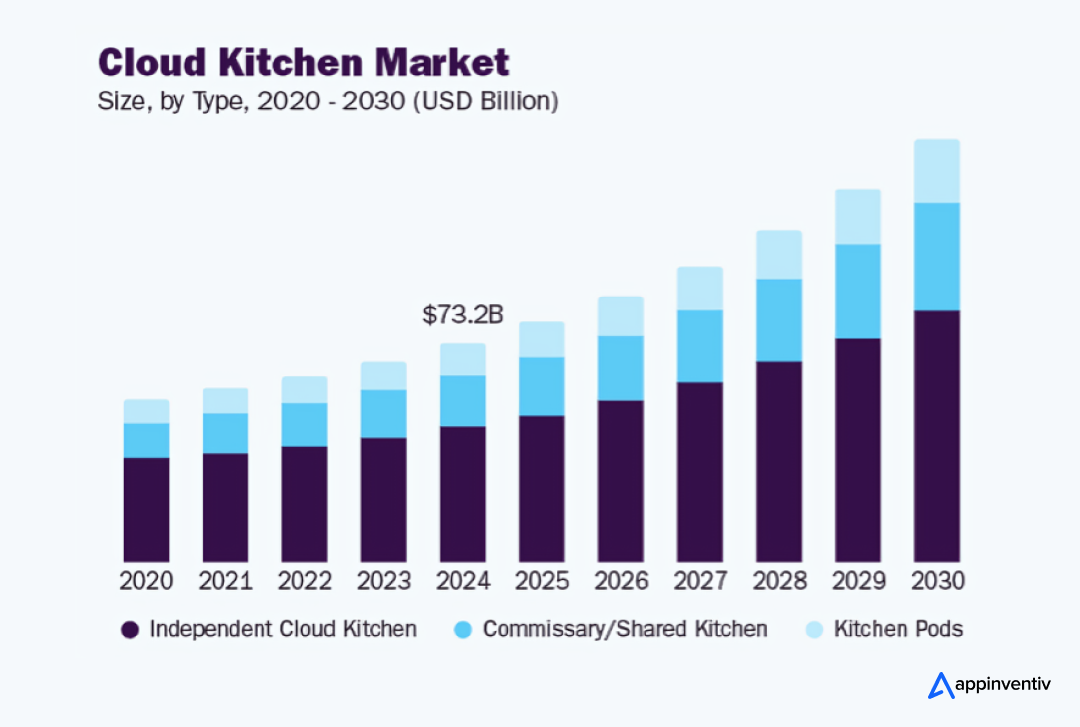
As consumers increasingly demand convenience and digital ordering, this scalable, cost-effective model is becoming the future of dining, putting food quality and delivery speed at the forefront. Rising online food delivery demand, cost-effective operations, and technological advancements like AI-driven automation and smart kitchen management drive this growth. Changing consumer preferences for convenience and diverse menus have fueled virtual brand expansion, while sustainability efforts in packaging and waste management are shaping the industry. As a result, cloud kitchens are redefining the future of dining with innovation and efficiency.
This blog will explore how cloud kitchens operate, their current market position, the essential steps to build a cloud kitchen platform, key features, setup process, costs, and effective monetization strategies. Let’s dive in!
The Cloud Kitchen Market: Where it Stands Today
The cloud kitchen market has seen remarkable growth in recent years, driven by technological advancements and changing consumer demands. As the need for food delivery services rises, companies continuously seek innovative solutions to streamline operations, reduce costs, and improve efficiency. Integrating AI and automation has reshaped the industry landscape among the various trends. Here are some notable innovations:
- AI-Powered Robotic Kitchens Expanding: Companies like Botinkit are deploying AI-driven robot chefs that autonomously prepare meals, helping cut labor costs and reduce food waste. These robotic kitchens are operational in 19 countries, with expansion plans into Europe and the U.S., marking their growing influence on the global market.
- Reef Technology’s Shift from Ghost Kitchens to Grocery Delivery (U.S.): Once valued at $1 billion, Reef Technology is pivoting away from its cloud kitchen model due to declining demand. The company now focuses on micro-fulfillment centers and grocery delivery services in the U.S., adapting to evolving consumer needs and exploring new growth avenues.
Everything About Kitopi Kitchen
One of the most popular cloud kitchens in Dubai, Kitopi connects with restaurants that need to deliver their food online. Established in 2018, they enable restaurants to work out of different locations without making any infrastructure and software investments.
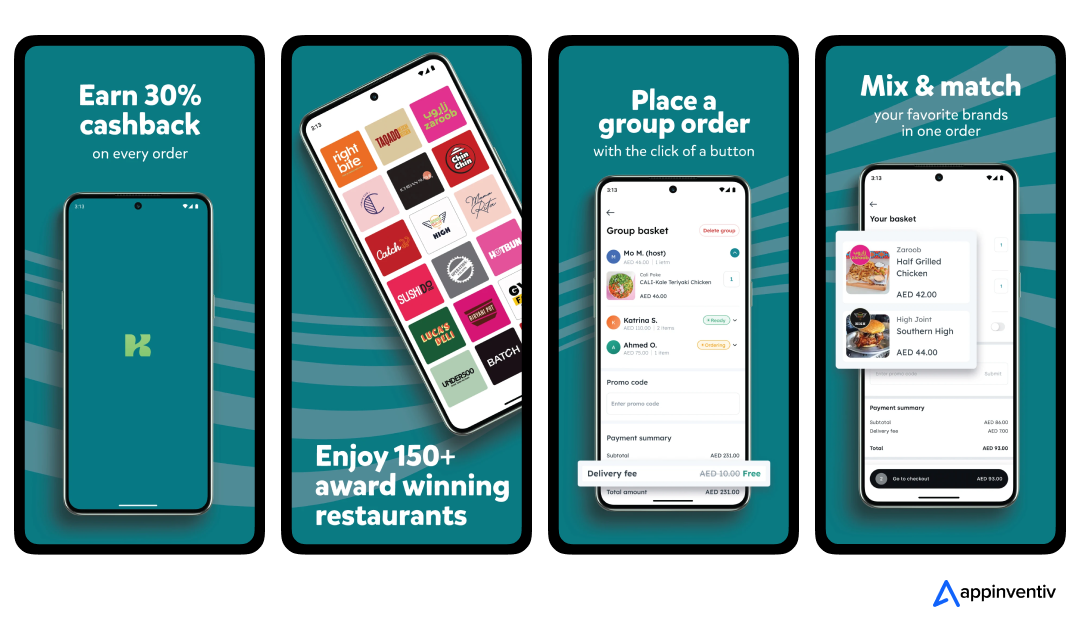
What makes Kitopi special is how it helps restaurants grow without the hassle of managing their kitchens. It’s a cloud kitchen platform that handles everything—from receiving orders and preparing food to handling deliveries and customer feedback.
At the heart of its operations is its Smart Kitchen Operating System (SKOS), a technology that streamlines kitchen processes, reduces waste, and ensures food is prepared efficiently. By managing supply chains, staff training, cooking, and logistics, Kitopi allows restaurant brands to focus on their food while it handles the rest.
Kitopi operates with a hub-and-spoke model: food is prepared in large central kitchens and then sent to smaller satellite kitchens closer to customers for final touches before delivery. Restaurants join Kitopi by paying an onboarding fee, and the company earns a share of their sales while also giving them a royalty. Recently, Kitopi has expanded beyond delivery-only services to include dine-in experiences, making it a more flexible option for restaurant brands.
Now that we understand what a cloud kitchen is and how Kitopi operates within this model let’s explore how you can start your cloud kitchen anywhere.
Steps to Build a Cloud Kitchen Platform like Kitopi
Setting up a cloud kitchen platform like Kitopi requires a strategic approach that combines business planning, operations management, and technology development. Here’s a step-by-step guide to help you build a Kitopi kitchen:

Choose the Right Business Model
Determine the best model for your Kitopi kitchen, whether it’s a single-brand kitchen serving one restaurant, a multi-brand kitchen hosting multiple brands, or an aggregator-owned platform partnering with delivery services.
Each model involves different revenue-sharing structures and operational needs. Opt for a scalable model that aligns with your long-term goals, as multi-brand kitchens can offer greater growth opportunities.
Design a Scalable and Robust Platform Architecture
Your platform’s architecture is crucial to ensure it can scale as your business grows. Opt for a cloud-based architecture that supports high scalability, reliability, and flexibility. Utilize the microservices architecture to ensure that different services, like ordering, payment processing, and delivery logistics, can operate independently and scale as needed.
A solid backend architecture will also ensure that your platform can handle heavy traffic and orders during peak times without crashing.
Build a Seamless Order Management System (OMS)
The Order Management System (OMS) is the heart of your cloud kitchen platform. It will manage everything from order placement to inventory management, and it should be capable of sending orders to the appropriate kitchen, tracking order status, and updating customers in real-time.
The OMS needs to sync seamlessly with the kitchen display system and the delivery platform to ensure smooth and efficient order processing. Additionally, the system should support both online and offline ordering for flexibility, particularly in areas with poor internet connectivity.
Also Read: Custom Order Management Software Development Cost
Implement an Effective Kitchen Display System (KDS)
To manage food preparation efficiently, you’ll need a robust Kitchen Display System (KDS). This system will help kitchen staff keep track of orders, cooking times, and priorities in real-time. It’s essential to ensure the KDS integrates well with the OMS, so orders are sent directly to the kitchen for processing.
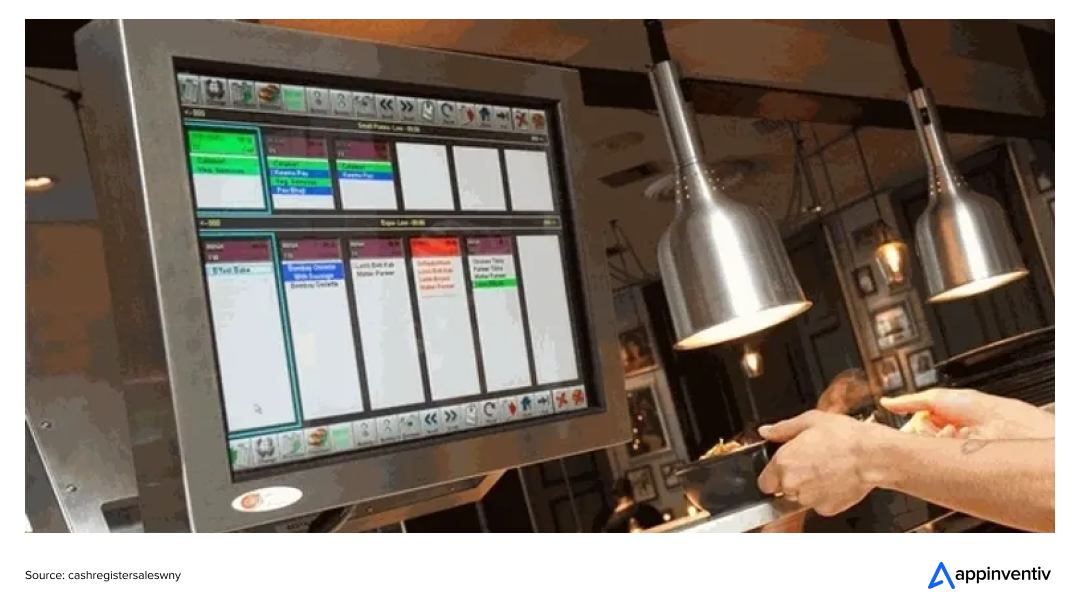
The KDS interface should be user-friendly, providing staff with easy-to-read order details, cooking instructions, and alerts when orders are ready.
Design a User-Friendly Interface for Customers and Admins
Your platform must offer an intuitive and easy-to-navigate interface for both customers and administrators. For customers, design an online ordering platform (either a mobile app or website) that allows them to browse menus, place orders, and track deliveries with minimal effort.
Ensure it’s mobile-friendly, as many users will place orders on their smartphones. Develop a comprehensive admin dashboard for administrators to track orders, monitor kitchen and delivery performance, and manage restaurant partners.
Restaurant Onboarding and Partner Management
A smooth onboarding process for restaurant partners is crucial for your platform’s success. Create a simple yet detailed onboarding system that allows restaurants to register, upload their menus, set prices, and manage inventory.
The onboarding tool should also provide easy access to performance reports, sales data, and customer feedback. Offering seamless integration with restaurant POS systems ensures that order details are automatically updated, avoiding potential errors in order fulfillment.
Ensure Security and Data Privacy
As a platform handling sensitive customer and financial data, security is paramount. Implement strong encryption, multi-factor authentication, and regular security audits to protect your users’ personal and payment information.
You should also be compliant with data privacy laws like GDPR or CCPA to ensure that customer data is handled responsibly and ethically. Trust is crucial for a cloud kitchen, so maintaining a high-security standard will build customer confidence in your platform.
Conduct Thorough Testing and Quality Assurance
Before launching your platform, conduct extensive testing to ensure that it functions as expected. This should include load testing to simulate high-traffic scenarios, stress testing to identify potential system failures under pressure, and functional testing to ensure all features work correctly.
It’s important to also test for usability across different devices and operating systems, ensuring customers and restaurant partners have a smooth and efficient experience on the platform.
Launch, Monitor, and Iterate
Once your platform is live, continuously monitor its performance. Use real-time analytics to track user behavior, identify bottlenecks, and gather customer feedback. Regularly update the platform based on user needs and technological advancements.
Over time, you can add more features, expand to new regions, or integrate with additional delivery services or restaurant chains to grow your platform. Keep improving and innovating based on market demands and customer expectations.
Must-Have Features of a Kitchen Platform like Kitopi
The right features in a kitchen platform are essential for optimizing operations, increasing efficiency, and ensuring smooth coordination across teams. These features help meet customer demands swiftly, reduce errors, and improve overall service quality, ultimately driving business growth. Let’s have a look at those.

- Order Management System (OMS): Efficiently manages orders in real-time, tracks order status, and integrates with kitchen and delivery systems for seamless processing.
- Payment Gateway Integration: Integrates with multiple payment gateways to handle secure transactions, supporting various payment methods like cards and wallets.
- Real-Time Delivery Tracking: Provides live updates on order status and delivery, ensuring efficient and timely delivery with route optimization.
- Cloud-Based Infrastructure: Ensures scalability and performance by utilizing a secure, cloud-based system that can handle high traffic and data.
- Multi-Brand/Restaurant Support: Supports multiple restaurant brands on one platform, allowing for individual menus, pricing, and promotions per brand.
- Inventory Management: Monitors inventory levels in real-time, helping restaurants avoid stockouts or overstocking and streamline operations.
- Analytics and Reporting Dashboard: Provides data insights on sales, customer trends, and performance metrics, enabling data-driven decisions and optimization.
- Kitchen Display System (KDS): Displays real-time order information to kitchen staff for efficient food preparation and task prioritization.
- Admin and Restaurant Dashboard: Offers an intuitive interface for managing orders, performance, and customer feedback for admins and restaurant owners.
- Customer Feedback and Rating System: Allows customers to leave ratings and reviews, helping improve restaurant performance and maintain service quality.
- Automated Communication Channels: Sends automatic notifications to customers and staff about order updates, improving communication and efficiency.
- High-Level Security and Data Protection: Includes strong encryption and secure login protocols to protect sensitive customer and financial data.
- Customizable Menu and Pricing Management: Allows easy updates to menus, pricing, and promotions in real-time, offering flexibility to restaurants.
- Integration with Delivery Platforms: Integrates with third-party delivery services to manage orders across different platforms and ensure timely delivery.
- Marketing and Promotion Tools: Integrates features like loyalty programs and promotions to boost customer engagement and repeat business.
Also Read: 10 Must-Have Features For Your Restaurant App
How to Set Up a Cloud Kitchen Anywhere in the World
There are multiple aspects of starting a cloud kitchen. For better clarity, we have divided those into three parts – Choosing a model, operational considerations, and technical requirements. Let’s start from the first.
Choosing the Best Cloud Kitchen Model
Standalone Kitchen
This is the most popular cloud kitchen model, in which a single concept is followed, and one or two food options are provided. For example, think of a pizza joint with a menu of between ten and fifteen items.
Cloud Restaurants
A cloud restaurant is usually a brand that works inside a restaurant. Here, the infrastructure of an existing restaurant is used to offer a range of food menus. These kitchens are listed under different brand names on third-party food aggregators like Uber Eats.
Co-working Cloud Kitchen
It is a model with individual kitchen units for every brand – all operating out of one kitchen space. These kitchens are very large, with ample space for multiple restaurants to rent out and expand their business.
Aggregator Cloud Kitchen
This is typically an extension of a coworking cloud kitchen system. The main purpose here is to provide infrastructure to the restaurants that need to make food for delivery only. Here, there is a huge reliance on food aggregators to handle the delivery operations.
Usually, the cloud kitchen cost varies, depending on the model you choose. Here’s what the approximate valuation looks like –
| Cloud Kitchen Model | Platform Development Cost |
|---|---|
| Standalone Kitchen | $20,000+ |
| Cloud Restaurant | $20,000+ |
| Co-working Cloud Kitchen | $30,000+ |
| Aggregator Cloud Kitchen | $35,000+ |
Operational Considerations of Cloud Kitchen
Location
While it is true that the cloud kitchen does not need a high-end location and space to match the vibes owners are aiming to match, it should be closer to the target group. Since the essence of ghost kitchens lies in making deliveries faster, they must be near the deliverable areas.
The best thing about them is that cloud kitchens can be set up in residential areas, unused parking lots, and even movable food trucks.
License
Unlike generally assumed, licenses are an important part of the cloud kitchen ecosystem. Since the customers cannot personally visit the outlet to see the food safety, hygiene, etc., it helps to get certifications and licenses, which give confidence in your food quality.
Kitchen and Packaging Equipment
Your equipment will depend entirely on the food you want to prepare. The more complex and wide you keep the menu, the more extensive the equipment list will be. To start, you can only invest in a fridge, stove, oven, counters, and cooking utensils.
The next part you will have to consider is the packaging. You will have to pay key attention to this, as irrespective of how good the food is, bad packaging can ruin the customer experience.
Kitchen Staff
Since the cloud kitchen is usually the backend of the restaurant system, you will only need the cooking and cleaning staff. A team that knows how to cook food while ensuring complete hygiene will be enough to get you started in the restaurant business.
Technical Requirements Of Cloud Kitchen
POS System
A POS system gathering orders from multiple aggregators is possibly the biggest restaurant feature needed for a cloud kitchen. The integrated POS system would take orders from various sources while maintaining real-time records. This way, you can analyze which platform works best for your business and how to take that traffic to your software.
Online Ordering Software
When you partner with a third-party aggregator to host your menu and manage deliveries, you end up paying them 12% to 18% for online orders and 18-25% for deliveries. Now, while the visibility they can get you is unquestionable, it would be equally crucial to have your own online order software – a web app or mobile application. This software can be linked with your POS and KDS to ensure a holistic in-restaurant experience.
Integrated Kitchen Display System
Food preparation in the case of cloud kitchens typically takes some 15-20 minutes. Here, using a kitchen display system comes in very handy when optimizing the order processing time. How? The order gets updated in the KDS when it is received; from there, the staff can view, prepare, and plan order delivery accordingly.
This doesn’t just make operations smooth but also helps identify delays and loopholes in the process.
Food Delivery System
When it comes to food delivery in a cloud kitchen, you have two options: either take control of the delivery in-house or partner with a third-party aggregator. While the former makes the delivery convenient, it comes with management and hiring cost complexity. In case of the latter, you can easily assign orders to the nearby delivery person by using a food delivery system.
Inventory Management System
For any restaurant business, managing inventory is crucial. A robust inventory management software would enable tracking of daily inventory usage while giving you insights into when to restock items. This, in turn, will help lower wastage costs.
So here are the different aspects of what is a cloud kitchen, what you need to know about the Kitopi platform, and how to build a cloud kitchen platform of your own. The only thing that remains is gathering an understanding of how much do cloud kitchens cost. Let’s look into that next as we conclude the piece.
How Much Do Cloud Kitchens Cost?
The cost of setting up a cloud kitchen, like Kitopi, varies based on technology, kitchen infrastructure, equipment, licensing, and operational needs. A comprehensive cloud kitchen setup, including a mobile app and website for restaurant management and order processing, typically falls within the range of $30,000 to $250,000, depending on the level of automation and customization required.
Here’s a breakdown of the estimated costs:
| Component | Estimated Cost (USD) |
|---|---|
| App & Website Development | $16,000 – $50,000 |
| Kitchen Infrastructure Setup | $30,000 – $100,000 |
| Equipment & Utilities | $20,000 – $80,000 |
| Licenses & Permits | $2,000 – $15,000 |
| Marketing & Branding | $5,000 – $30,000 |
| Delivery & Logistics Setup | $10,000 – $50,000 |
| Total Estimated Cost | $30,000 – $250,000 |
The final cost depends on the scale of the operation, location, level of technology integration, and business model. If you plan to include AI-driven automation, smart inventory management, and advanced analytics, the cost will be on the higher end of the spectrum.
How to Monetize a Cloud Kitchen Platform
Cloud kitchens rely on digital-first operations, allowing multiple revenue streams beyond just selling food. By leveraging a combination of these strategies, cloud kitchen operators can create multiple revenue streams and build a scalable, profitable business. Here are some effective ways to generate revenue from a cloud kitchen platform:
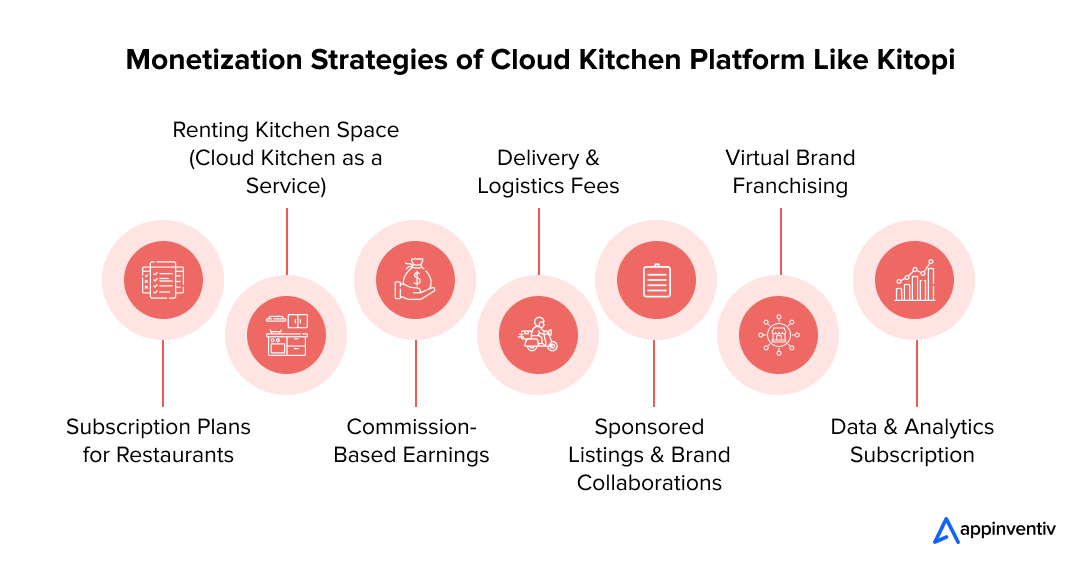
Subscription Plans for Restaurants
Offer tiered subscription plans where restaurants pay a fixed monthly or annual fee to access platform features like order management, analytics, and marketing tools.
Example: Charging $200- $1,000 per month for premium services.
Renting Kitchen Space (Cloud Kitchen as a Service)
Lease out fully equipped kitchen spaces to food brands or startups that want to operate without investing in physical locations.
Example: Renting kitchen space for $2,000–$10,000 per month, depending on size and equipment.
Commission-Based Earnings
Charge restaurant partners a percentage of every order placed through the platform. This is a common revenue model for food aggregators.
Example: Taking a 15-30% commission per order.
Delivery & Logistics Fees
Charge restaurants or customers for delivery services through a flat rate or distance-based pricing model. Some platforms also offer fleet management as an additional service.
Example: Charging $2–$5 per delivery or using dynamic pricing based on distance.
Sponsored Listings & Brand Collaborations
Allow restaurants or food brands to pay for better visibility on the platform, such as top search rankings or featured placements.
Example: Charging $500–$5,000 monthly for priority listings and promotions.
Virtual Brand Franchising
Develop proprietary cloud kitchen brands and license them to food entrepreneurs or restaurants that want to expand without setting up physical space.
Example: Franchise fees between $10,000–$50,000, plus a percentage of revenue.
Data & Analytics Subscription
Sell insights and analytics on customer behavior, peak order times, and menu optimization to restaurants looking to improve their operations.
Example: Charging $100–$1,500 monthly for business intelligence reports.
Launch Your Digital-First Cloud Kitchen with Appinventiv
The cloud kitchen industry is experiencing a rapid transformation, driven by technological advancements and evolving consumer demands, and platforms like Kitopi are no exception. Emerging trends such as AI-powered automation, multi-brand virtual kitchens, and hyperlocal delivery hubs are reshaping the market, enabling businesses to reduce costs while maximizing efficiency.
The rise of sustainable packaging and subscription-based meal plans also reflects the growing consumer preference for convenience and eco-friendly solutions. With lower operational expenses, higher profit margins, and data-driven growth strategies, cloud kitchens present a lucrative opportunity for entrepreneurs looking to capitalize on the booming online food industry.
To help businesses succeed in this space, Appinventiv has partnered with global food brands like KFC, Domino’s, and Pizza Hut, developing cutting-edge digital solutions tailored to the food-tech industry.
For instance, we collaborated with the Pizza Hut mobile app, assisting the brand in expanding into Middle Eastern markets. Through our innovative UI/UX development, the brand experienced a 30% increase in conversion rates.
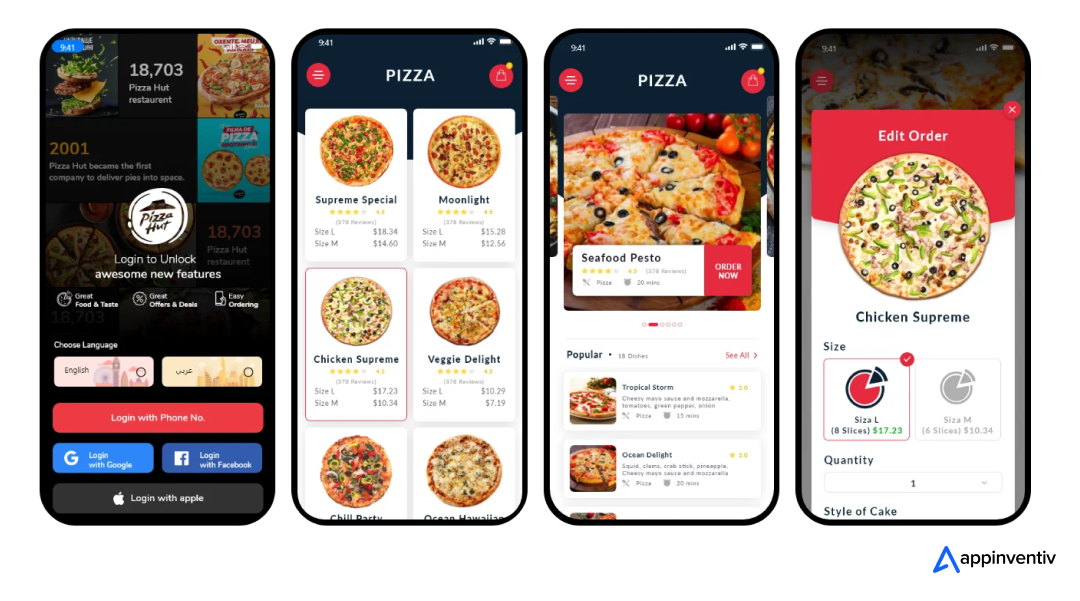
From custom cloud kitchen software and AI-driven order management to logistics optimization and predictive analytics, Appinventiv ensures seamless operations and scalability.
Our cloud consulting services help businesses build high-performing, future-ready cloud kitchens like Kitopi, ensuring success in the competitive food delivery market.
We hope that everything we covered in this blog will be enough to get you started on your aspirations to become a cloud kitchen owner with utmost confidence.
There’s only one thing left to do now. Contact with the Appinventiv team of restaurant app engineers and initiate your journey.
FAQs
Q. How does cloud kitchen work?
A. Cloud kitchens are a type of centralized commercial food production facility where more than one restaurant can rent space for preparing delivery-optimized cuisines. A single restaurant may have multiple brands under it, all operating under a single roof. Cloud kitchen is all about featuring a large warehouse with numerous mini restaurants stationed with stainless steel prep tables, stoves, hood vents, sinks, and ovens each having it’s soon order coming from different customers.
Cloud kitchens are highly tech-enabled and they take advantage of the ubiquitous food delivery on your smartphones like Grubhub, UberEats, and Doordash.
Q. Are there any challenges in setting up ghost kitchens?
A. Any new technology like a ghost kitchen setup also has some potential drawbacks or challenges along with the benefits. Let’s check them out.
- Reliance on third-party delivery apps
- Working with on-demand staff
- Competition in a crowded digital marketplace
- Food safety and food quality
- Compliance with local food safety regulations
Q. How to build a cloud kitchen platform?
A. Here is a step-by-step process on how to build a cloud kitchen platform.
- Opt for a cloud kitchen model including stand-alone kitchens, cloud restaurants, aggregator kitchens, and co-working cloud kitchens.
- Choose a setup location, as a cloud kitchen cannot work without a specific kitchen space
- Get the proper license required to run your cloud kitchen and stay legally secured
- Hire experienced kitchen staff
- Gather all the kitchen equipment required for preparing cuisine and serving your customers
- Hire a software development partner
- Integrate inventory management and restaurant management system
- Integrate payment, CRM, and POS system
- Integrate order management system
- Test and promote
Q. What are some of the popular cloud kitchen business models?
A. There are basically four types of cloud kitchens including cloud restaurants, aggregator kitchens, stand-alone kitchens, and co-working cloud kitchens. All you need to do is choose an ideal type of cloud kitchen model type for one of your chosen food delivery business ideas. Let’s dig deeper into each type:
Standalone kitchen: In this model, the business directly takes orders and prepares meals and has a limited number of dishes.
Cloud restaurant: This business model works inside the kitchen of an existing restaurant and uses its infrastructure for preparing dishes based on orders.
Co-working business model: Various online restaurant operates in a single place where each brand pays rent.
Aggregator cloud kitchen: This is an extended version of the co-working cloud kitchen. In the aggregator model, the kitchen infrastructure is offered to restaurants which required to make food for delivery purposes only.
Q. How to invest in cloud kitchens?
A. Investing in cloud kitchens can be lucrative, but it requires careful consideration of various factors. Here’s how to approach it:
- Research the demand for delivery-only food services in your target market.
- Decide whether to build your cloud kitchen or invest in an established platform.
- Explore potential partnerships with well-known brands or operators.
- Assess the quality of kitchen infrastructure, delivery logistics, and technology support.
- Evaluate the scalability, profitability, and operational costs of the business.
- Develop a clear investment strategy by analyzing the market and competition.


- In just 2 mins you will get a response
- Your idea is 100% protected by our Non Disclosure Agreement.

How to Build a Robust Multi-Cloud Strategy for Future Readiness
Key takeaways: Multi-cloud adoption is growing and 76% of enterprises have already embraced multi-cloud environments. Avoiding vendor lock-in is a major driver for businesses moving to multi-cloud strategies. Cost optimization and enhanced security are key benefits of multi-cloud adoption. Businesses must align their multi-cloud strategy with business objectives for scalability, security, and innovation. Seamless integration…

How Cloud Analytics Helps Businesses Make Data-Driven Decisions Faster
Key takeaways: Cloud analytics accelerates decision-making by offering real-time insights and scalability. Businesses gain cost efficiency, enhanced agility, and improved accuracy with cloud analytics. Leveraging AI and big data empowers faster, smarter decision-making in industries like e-commerce, healthcare, and finance. While implementing cloud analytics, businesses face challenges like data security and integration, but there are…

Transforming Legacy Systems with Cloud Migration: The Whys and Hows
Key takeaways: Legacy systems hinder innovation, security, and agility, making cloud migration a strategic imperative. A successful legacy to cloud migration hinges on careful planning, choosing the right strategy, and robust execution. Benefits of cloud migration for legacy systems include enhanced scalability, fortified security, and significant cost optimization. Industry-wide use cases demonstrate the transformative power…


















